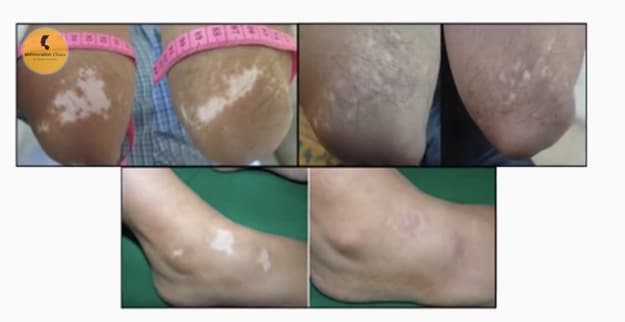Vitiligo Treatment in Delhi
Vitiligo is a type of skin disease that arises when the skin cells which produce the colour gets destroyed. The skin cells present in the human body are called Melanocytes which are responsible for skin pigmentation. It is a condition where skin loses colour and pale or white patches start appearing. Vitiligo is estimated to affect about 1% of the world population. When this occurs to a person, they start destroying even the mucous membrane tissues that are present in the nose, mouth and eye. So there are chances that the eyes become discoloured too.
What are the common causes of Vitiligo?
The skin cells are otherwise called as the Melanocyte that produces melanin or colour.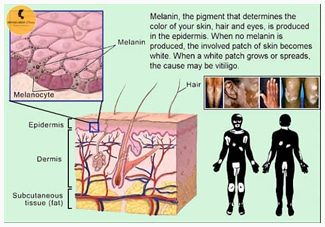 This melanin is the reason for having a normal skin tone and in Vitiligo patches, this is absent. The definite cause for this disease is still not known but it is defined as an autoimmune disease. Autoimmune disease, in this case, means that the immune system in a body attacks its own skin cells. People can suffer from other minor autoimmune diseases too. It can also happen genetically or due to emotional stress and sunburn. All these reasons are not scientifically proven yet.
This melanin is the reason for having a normal skin tone and in Vitiligo patches, this is absent. The definite cause for this disease is still not known but it is defined as an autoimmune disease. Autoimmune disease, in this case, means that the immune system in a body attacks its own skin cells. People can suffer from other minor autoimmune diseases too. It can also happen genetically or due to emotional stress and sunburn. All these reasons are not scientifically proven yet.
Who is affected by Vitiligo?
Usually, people can be affected by this disease in their twenties. Young children may or may not be affected by this from their parents’ genes. Many estimations and statistics tell that vitiligo can affect people at any age and to all genders. It is quite common with people having a dark complexion. People having autoimmune diseases like thyroid can be affected too.
Is vitiligo hereditary?
About 20% of people having vitiligo disease have developed due to hereditary, so the disease does have a genetic basis. This doesn’t imply that every case is caused only by hereditary.
Types of Vitiligo?
Generally, there are two types of vitiligo:
- Segmental Vitiligo
- Non-Segmental Vitiligo.
Both of them are entirely different from each other. Here is a brief description of both the types.
Segmental Vitiligo or Unilateral Vitiligo
Segmental Vitiligo is also known as Unilateral Vitiligo which is non-symmetrical in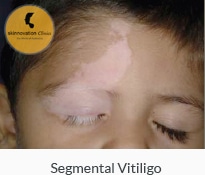 nature. It is not very common and only 10% of people are there who have this type of vitiligo. But it is common in children and is characterized by one or more body parts that have lost melanin. It is usually seen in areas like legs, arm and face. This can result in whitening of hair also. It is associated with thyroid and other autoimmune diseases.
nature. It is not very common and only 10% of people are there who have this type of vitiligo. But it is common in children and is characterized by one or more body parts that have lost melanin. It is usually seen in areas like legs, arm and face. This can result in whitening of hair also. It is associated with thyroid and other autoimmune diseases.
Usually, this segmental vitiligo lasts for a year and then stops. It has got a high response for surgical treatment because of its predictable stability.
Non-segmental Vitiligo
Non-segmental vitiligo is the most common type of vitiligo and affects 90% of vitiligo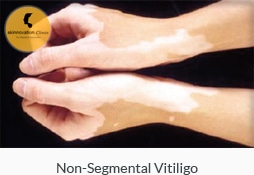 patients. It can either be focal or generalized. The focal is the evolving stage of non-segmental vitiligo while generalized is also known as Vitiligo Vulgaris. It is the condition that occurs on both sides of the body. It can begin from any part of the body like around the eyes, mouth, hands, wrist, fingertips or feet. When it begins, the patient will undergo rapid loss of skin colour at the start and stops after some time. They again start losing colour after some time at a rapid rate, this continues until the end of the patient’s lifetime.
patients. It can either be focal or generalized. The focal is the evolving stage of non-segmental vitiligo while generalized is also known as Vitiligo Vulgaris. It is the condition that occurs on both sides of the body. It can begin from any part of the body like around the eyes, mouth, hands, wrist, fingertips or feet. When it begins, the patient will undergo rapid loss of skin colour at the start and stops after some time. They again start losing colour after some time at a rapid rate, this continues until the end of the patient’s lifetime.
There are high chances of developing Koebner’s Phenomenon which is a depigmentation symptom. As time passes, the colour loss intensifies and propagates to larger areas. Acrofacial and Mucosal vitiligo are also other types of generalized vitiligo. Like the names suggest, acrofacial means involving fingertips and face while mucosal involves lips and genitalia.
How is Vitiligo treated?
There are a number of discovered methods like phototherapy (PUVA or NB-UVB), Melanocyte transplantation surgery and immuno-modulators. There is excimer treatment for curing vitiligo. It cannot be completely cured but these processes can stabilise the disease and forms new pigment on the areas having white patches.
What is Phototherapy with UVA Light (PUVA)
In phototherapy, the patient is given a drug to increase skin sensitivity against UV light. Then for a period of 6-12 months, the affected places are exposed to a high dose of UVA light for at least 2 times a week.
What is NB-UVB Phototherapy
This treatment uses UltraViolet B rays that can be done at home with help of UVB lamps too. This can be done daily at home or for 2-3 times for a week in clinics. This is useful if white spots are covered in large areas of the body.
What is Melanocyte Transplantation?
Melanocyte transplantation is a surgical treatment done to replenish new Melanocyte in the affected areas. A small portion of normally pigmented skin is obtained and then the good functioning melanocytes are taken. These are converted to a liquid suspension which is applied on the vitiligo areas. After a few weeks, these perforate into the skin to produce melanin. This process is called ‘non-cultured epidermal cell suspension transfer’ or ‘non-cultured cellular grafting’. It is commonly called as the ‘melanocyte-keratinocyte transplantation procedure’.
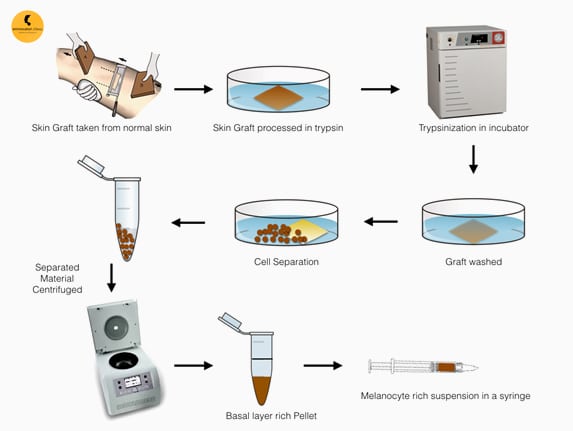
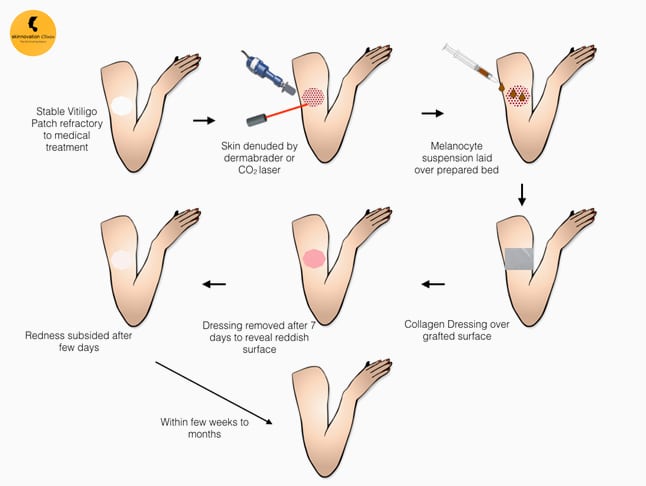
What is Excimer Laser?
Excimer laser treatment is a very common treatment for dark-skinned vitiligo patients. This uses a highly focused beam of light which will be delivered through a strong fiber optic device. This allows only the affected skin to be exposed to strong UVB light without disrupting the normal skin. It is usually done for patches on the face.
So which is the best treatment for me?
Every vitiligo condition is different and treatments for different people will vary from each other. So it is recommended that you consult an experienced dermatologist before starting any treatment for vitiligo. They can suggest the best treatment after analysing your condition.
Dr. Sumit Gupta is one such talented dermatologist in Delhi to offer the best Vitiligo treatment and Melanocyte Transplant. Dr. Sumit Gupta is exceptionally trained and has been part of different path-breaking research in this field. His approach towards patients is research and evidence-based, meticulous and is acceptable to the international guidelines.
You can book an appointment for Vitiligo treatment in Delhi with Dr. Sumit Gupta by contacting us at +91-9560064696 or info@sumitguptamd.com
